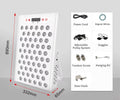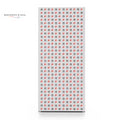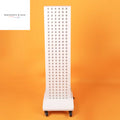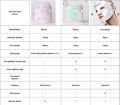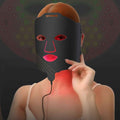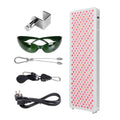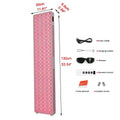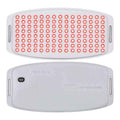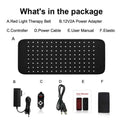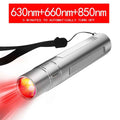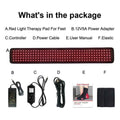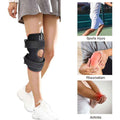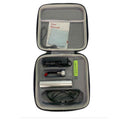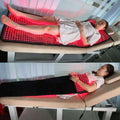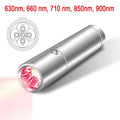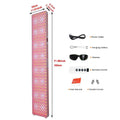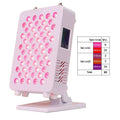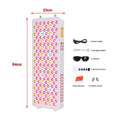Red Light Therapy Wavelengths Explained: Benefits & Science
Posted by MARK HINDLE

The penetration depth of light in biological tissues is a complex topic, influenced by wavelength, power, tissue type, and even individual variations. The values below are general approximations for therapeutic light (LEDs or low-level lasers) and assume reasonable power output.
Important Considerations:
Absorption by Chromophores: Different molecules in the body (chromophores) absorb light at specific wavelengths. Melanin (skin pigment), hemoglobin (in blood), and water are major chromophores that influence penetration.
Scattering: Light can be scattered as it passes through tissue, which reduces its effective depth. Longer wavelengths tend to scatter less than shorter ones.
Effective Depth vs. Total Penetration: While light might eventually travel a certain distance, its effective therapeutic depth is where enough photons remain to elicit a biological response.
Here's a breakdown by wavelength:
Visible Light (Shorter Wavelengths):
400nm (Violet/Blue-Violet):
Skin: Very superficial, primarily absorbed in the epidermis (outermost layer). Less than 1mm, often cited as ~0.1-0.5 mm.
Joints/Bone: Negligible direct penetration. Effects would be entirely indirect.
450nm (Blue Light):
Skin: Primarily absorbed in the epidermis and superficial dermis. Around ~1 mm. Used for acne due to its effect on P. acnes bacteria.
Joints/Bone: Negligible direct penetration.
480nm (Blue Light):
Skin: Similar to 450nm, primarily targets the upper layers. Around ~1 mm.
Joints/Bone: Negligible direct penetration.
550nm (Green Light):
Skin: Penetrates slightly deeper than blue light, reaching the dermis. Around ~2 mm. Used for pigmentation, redness, and some inflammation.
Joints/Bone: Negligible direct penetration.
Visible Red Light:
630nm:
Skin: Targets the epidermis and dermis, reaching superficial layers. Around ~1-3 mm, but some sources suggest up to 4mm. Excellent for skin rejuvenation, wound healing, and collagen production.
Joints/Bone: Very limited direct penetration to deep joint structures or bone. May affect very superficial joint issues (e.g., finger joints) indirectly.
650nm:
Skin: Similar to 630nm, good for superficial skin issues. Around ~1-3 mm.
Joints/Bone: Limited direct penetration.
660nm:
Skin: Often considered a "sweet spot" for red light, penetrating well into the dermis. Around ~3-5 mm. Highly effective for skin, wound healing, and collagen.
Joints/Bone: Can have some effect on very superficial joint structures, but still minimal direct penetration to deeper bone or joint cartilage.
670nm:
Skin: Similar to 660nm, good penetration for superficial tissues. Around ~3-5 mm.
Joints/Bone: Limited direct penetration.
Near-Infrared (NIR) Light (Invisible):
810nm:
Skin: Passes easily through all skin layers.
Joints/Bone: Excellent penetration, reaching several centimeters (e.g., 3-5 cm, potentially up to 8 cm) into muscle, fascia, joint capsules, cartilage, and bone. Widely used for muscle recovery, pain relief, and brain health (due to skull penetration).
830nm:
Skin: Passes easily through all skin layers.
Joints/Bone: Similar to 810nm, with very deep penetration into muscles, joints, and bones. Often considered to have superior tissue penetration and broad cellular effects. Several centimeters (e.g., 3-5 cm, potentially up to 8 cm).
850nm:
Skin: Passes easily through all skin layers.
Joints/Bone: Also excellent for deep tissue penetration, reaching muscles, joints, and bones. Several centimeters (e.g., 3-5 cm, potentially up to 8 cm). Often combined with red light for comprehensive treatment.
1060nm:
Skin: Penetrates deeply through the skin.
Joints/Bone: While it has the potential for deep penetration due to reduced scattering, its effectiveness for photobiomodulation (cellular stimulation) can be limited in certain tissues due to increased absorption by water molecules compared to 810nm, 830nm, and 850nm. This absorption can lead to more heat generation and less light reaching the deeper cellular targets for biological effect. Still, it can reach several centimeters (e.g., 3-5 cm), and its heating effect can be useful for certain applications (e.g., adipose tissue targeting).
Key Takeaway: For deep tissue penetration (muscles, joints, bones), near-infrared wavelengths (especially 810nm, 830nm, 850nm) are generally the most effective. Visible red light is best for superficial skin and wound healing. Shorter visible wavelengths (blue, green) are primarily for surface skin conditions.
Blue and Green Light (for the "surface"): These colors are like a gentle touch for the very top layers of your skin.
Blue Light is great for acne. It zaps the bacteria that cause breakouts and can help calm oily skin. Imagine it cleaning up your skin's surface.
Green Light helps with redness and dark spots. It targets uneven skin tone, making your complexion look calmer and more even.
Red Light (for just below the surface): This light goes a little deeper than blue or green. It's fantastic for making your skin look younger, helping cuts heal faster, and reducing swelling right on the skin's surface.
Near-Infrared Light (for deep down): This light you can't even see, but it's the superhero for deep issues. It travels far into your muscles, joints, and even bones. This is why it's so good for easing pain, helping muscles recover after exercise, and soothing achy joints.
So, while blue and green lights are busy making your skin's surface look great, red and near-infrared lights are working deeper to help with healing and discomfort.



